Learning in the time of Covid
“The University does everything it can to make it as safe as possible. I felt less safe going to Tesco than I did in a lecture or lab.”
Will Bowles, Class of 2021 Biochemistry
“I hope to be back as soon as I possibly can, for us all to be healthy and to have the chance to get back to some sort of normality. It’s so important to stay connected.”
Dr Maggie Ellis, School of Psychology and Neuroscience
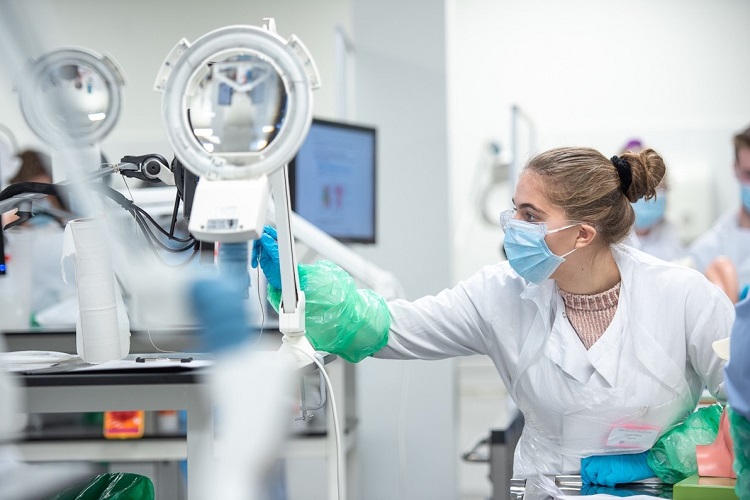
Following an unprecedented pandemic-times switch to virtual teaching in the Spring of 2020, a small but safe cohort of students finally returned to in-person teaching a few months later, in October, with the remainder completing their studies wherever they were in the world.
Back then, a poll run by the Students’ Association, found that more than 90 per cent of students who initially experienced in-person classes felt safe in the University’s Covid-19 adapted teaching environment, however, a significant number of students who had yet to attend physical classes remained concerned about returning in person.
Behind the scenes, academic, technical and cleaning staff worked hard to adapt working environments and make them as safe – and clean – as possible, with several rounds of virtual scenario planning, troubleshooting and in-person recces taking place before students were welcomed back for physical classes. With one-way systems, track and tracing and social distancing with PPE – not to mention five minutes less for each class for cleaning – last year’s teaching ended in a landscape like no other, and with even more guidance and support available than ever.
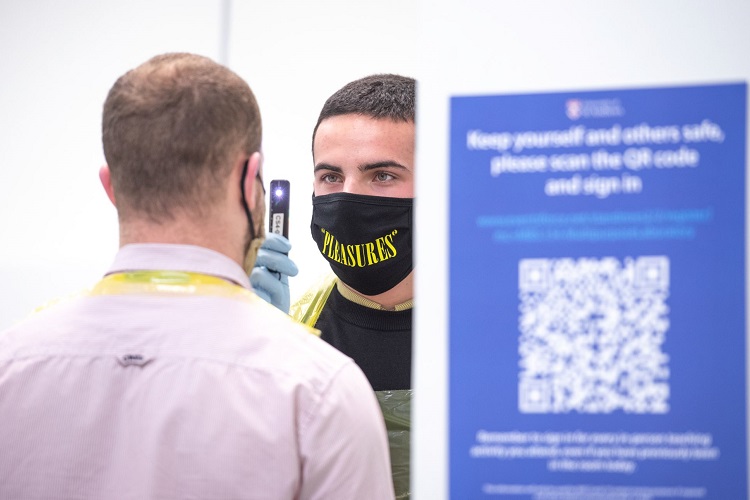
While most of us were learning how to use MS Teams for the first time, dual delivery teaching staff faced the additional and unenviable challenge of learning new software and ways to make online delivery as engaging and effective as possible.
In the end they typically excelled, with some going the extra St Andrews mile, from hosting tutorials with cupcakes on the East Sands to organising ‘Oscars’ style virtual awards ceremonies to celebrate class presentations.
In one of her regular emails to staff and students, Principal Professor Sally Mapstone said: “We know from last semester that our classrooms are a safe, fully risk-assessed environment for teaching, and that there has not been a single instance of Covid being transmitted in a class, a laboratory, or in any other educational setting.
“We have [protected ourselves and our community] while continuing to deliver teaching and research to exceptionally high standards, when our students have again excelled academically, and even when our community has been necessarily disrupted and dispersed.”
Thanking staff and students for everything they have achieved, individually, and as one ‘resilient and responsible community’, she said: “I do not for a second underestimate or take for granted the personal costs of the past year or how difficult it has been at times, but this is your collective achievement.”
Whether attending classes in newly adapted labs, teaching space or a lecturer’s living room, most students found it ‘a relief’ to be back, while for others it was less stressful studying online. Those returning safely to St Andrews, however, were mostly just happy to see (albeit partially) their friends again.
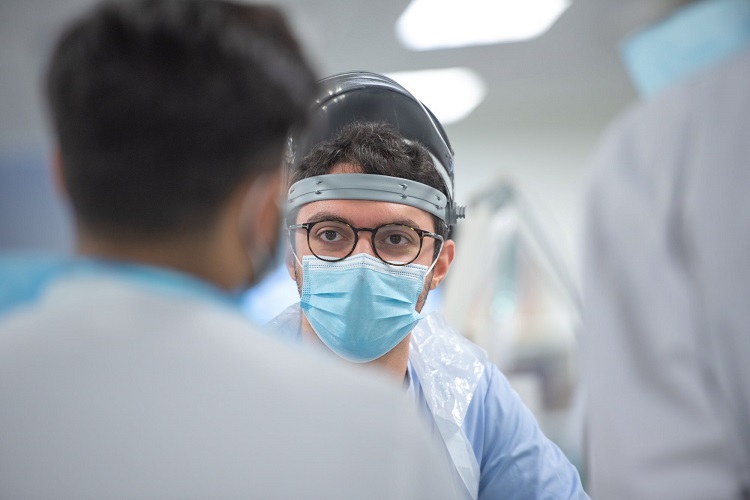
“The pandemic has brought out what is best about St Andrews: staff and students going the extra mile to succeed together,” commented Assistant Vice-Principal (Dean of Learning and Teaching) Professor Frank Müller.
“Teachers across the University have shown amazing stamina, imagination and dedication, while our students have demonstrated flexibility, resilience and a determination to succeed. As a result, we have achieved excellent student satisfaction scores as well as outstanding results – while managing to keep everyone safe.”
Indeed, the results of the University’s MEQs (Module Evaluation Questionnaires) for the two semesters in 2020-2021 reported an overall increase in students’ satisfaction with their modules. In addition, the 2021 NSS (National Student Survey) results for St Andrews saw our overall satisfaction rate (Q27) go up – against a uniform downward trend across the sector.
Almost one year on, the University will once again welcome new and returning students to this new normal environment of blended learning, with the vast majority of classes, tutorials, and seminars expected to be held in person in St Andrews.
In a message at the end of June 2021, Principal Mapstone noted that the first semester of 2021-2022 would be “one of transition”.
“Our return to normality after such an extended period of extreme and varying restrictions cannot be a sudden, crunching gear change, even if all major restrictions have gone,” she said.
“It must be a considered process in which we are all supported through a safe and reassuring return to study and work.”
The Principal’s message confirmed that the University community will be able to gather “far more than has been possible” over the past 18 months, with large lectures (35 people and over) remaining mostly online and recorded, with the option to study entirely online to be available to those who wish to do so.
To mark this period, and to look forward to the academic year ahead, we look back on how students and staff of the ‘new normal’ found their experience at the time. We spoke to those who were back in physical classes, as well as those learning at home who were shielding, and to teachers whose large classes proved too prohibitive to return.
We asked a range of teaching staff and students about their experience of both in-person and virtual teaching so far, whether teaching from their kitchen tables or learning in Covid-19 adapted University spaces. What was it like to teach during a pandemic? How did staff prepare for such a change, and how have students reacted?
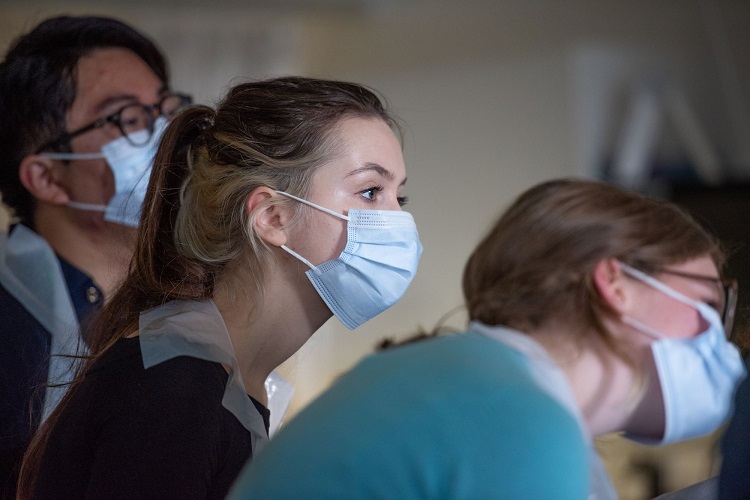
From tales of thirty-second commutes to the challenges of sharing table space with partners, siblings, children and pets, our academic staff learned some valuable lessons in planning and organisation, not least when it came to stocking up on coffee.
With some describing the new normal in teaching as ‘bizarre’, ‘surreal’ and ‘challenging’, noting a palpable sense of ‘apprehension’ and ‘ambiguous loss’, one message was clear: the importance of connection, whether in-person or via a virtual learning environment, and of feeling part of a community, was as valuable as ever.
Dr Brian Chalmers (School of Chemistry) teaches all undergraduate levels and initially switched to virtual teaching some modules as well as conducting Vivas online via Teams.
Brian restarted Semester 1, 2020, with in-person teaching, having been ‘very inventive’ with the use of space in order to adhere to social distancing and avoid cross-contamination.
“I spent the initial lockdown period at home in Dundee,” he said. “At first this was quite challenging in many ways. The first big challenge was adapting to a new routine as the morning commute now took about thirty seconds instead of twenty-five minutes. Another challenge was space. I didn’t have a dedicated office space so had to use the dining room table, which is where we eat. My wife was also working from home during the initial lockdown, but she volunteered to work from the spare bedroom, so I had the downstairs to myself.
“At this point, colleagues and I had about twenty Vivas outstanding. We had to cancel all the in-person ones we had booked for after the Spring break. All of these needed to be done using Teams during the initial lockdown. This was particularly challenging as neither staff nor students had any experience with Teams before this date.
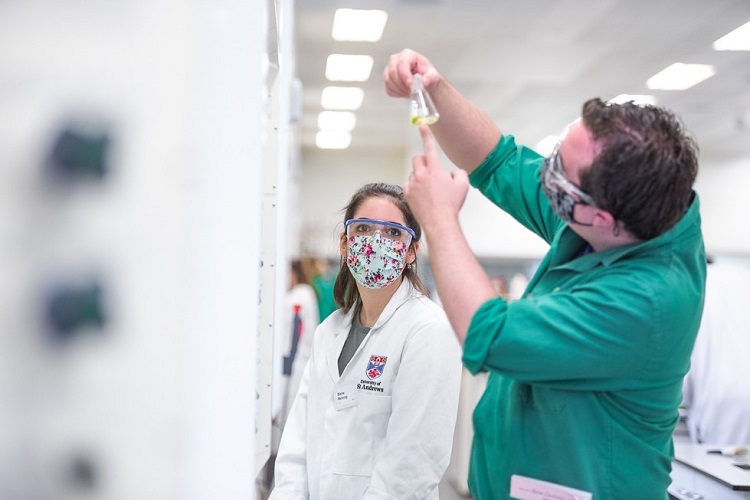
“The first big challenge was adapting to a new routine as the morning commute now took about thirty seconds instead of twenty-five minutes.”
Dr Brian Chalmers, School of Chemistry (pictured above right)
“I took various things home with me, from molecular models to printed flowcharts, to try and make doing an assessment across a webcam as easy as possible. I cleared a space on my dining room table as that was set to become my home office. I also bought a lot more coffee.
“It was incredibly strange at first. I am used to speaking to my family and long-distance friends through platforms such as Skype and WhatsApp, but it was very unusual using this method to communicate with students. I am sure the students found it rather bizarre too, but the actual delivery went very well, with only minor issues arising.
“I really missed the social interaction. The labs and tutorials are a great place to get to know students and build constructive learning environments and learn about how each student learns and approaches a task or problem.
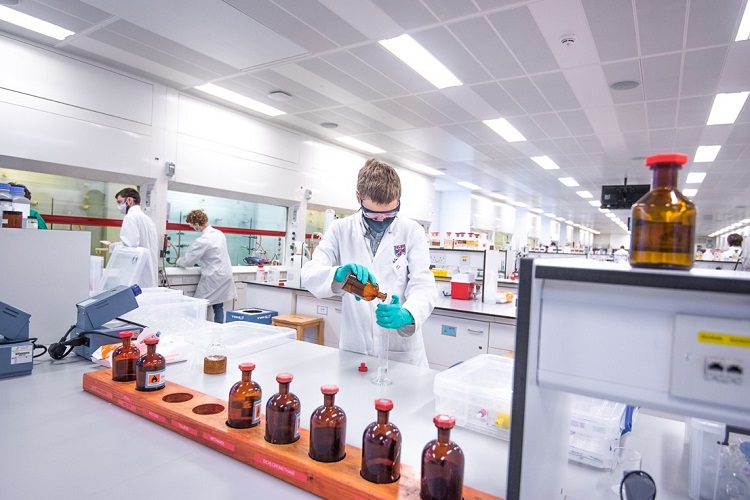
“Personally, I was a little bit apprehensive at first. I was worried our labs were going to be chaotic and challenging to manage. I was also concerned we would struggle to achieve the learning objectives and meet the needs of our students, given all the restrictions. However, after my first in-person bit of teaching in over six months, I instantly felt much better. Most things are going smoothly, and all the forward planning really has paid off.
“I think, overall, the students are thankful they are able to get some level of practical experience and are thriving in the labs. I think there was still a lot of anxiety in general because many students had their experiences cut short when the initial lockdown happened. We have been careful in our planning. We started by identifying what we could and could not do based on the restrictions. We also had several rounds of scenario planning to try and foresee potential issues, such as large numbers of students, or having plans in place for students who needed to miss class to self-isolate.
“The return of in-person teaching was welcomed by all. We have taken a great deal of time and put a large amount of thought into every aspect of in-person teaching to ensure it is working well and keeping everyone as safe as possible. I was glad to get back into the labs and the students were too.”
Meryem Rashidova, in her third year studying for a BSc in Chemistry, is a commuting student from Dundee. During the initial lockdown period her modules were all switched to online delivery and assessment, and she returned for physical, weekly classes in Week 2 of Semester 1, 2020.
She explained: “As a commuting student living at home in Dundee, I was fortunate that I did not have to worry as much as some of my friends who lived further away, with the uncertainty that lay ahead.
“Although it was sad to finish the year online, I believe it was the safest decision. To begin with, it was challenging studying online. Having to adjust my learning environment in a short space of time was quite stressful, especially with exams approaching. However, my lecturers and tutors made the transition as easy as possible, providing us with even more guidance and support than before.
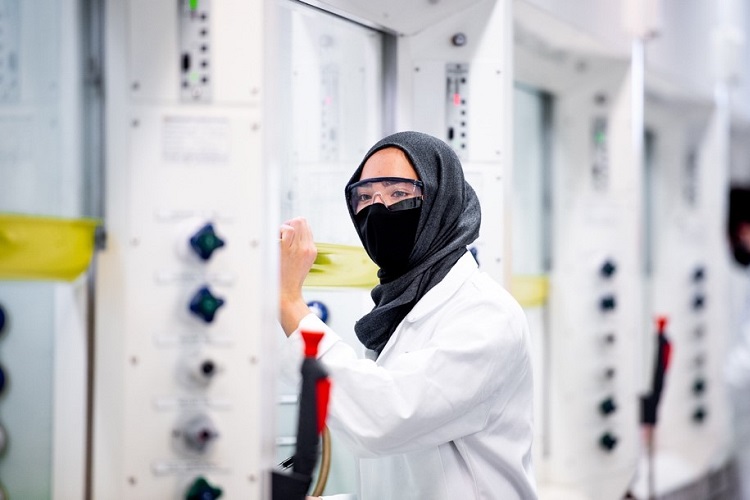
“My lecturers and tutors made the transition as easy as possible, providing us with even more guidance and support than before. I think returning to in-person teaching is as safe as it possibly could be.”
Meryem Rashidova, third year, Chemistry
“As I commute to St Andrews, I would mostly see my friends in lectures and study sessions, so it was very difficult not being able to see them for a long period. I also missed out on meeting in-person with my lecturers and other students in my new modules.
“After finishing my first year online, I was excited and looking forward to coming back and starting my second year with some in-person teaching.
“I have really enjoyed my experience with in-person teaching so far. I have made new friends in my lab and tutorials which I wouldn’t have if it was all online. It was also nice to see some familiar faces!
“If you are not an individual who has underlying health conditions or living with someone that does, I think returning to in-person teaching is as safe as it possibly could be.”
Dr Michael M Nevels (School of Biology) teaches all levels of both UG and PG students and spent the initial lockdown period in his flat in Anstruther. He had already completed his teaching for Semester 1 when the initial lockdown began, so his first in-person class was a lab practical in early October 2020.
He said: “I prepared for dual-mode teaching in Semester 2 by attending virtual workshops on how to use online platforms such as Moodle, Panopto and Teams. I also pre-filmed some practicals (for students unable to join in person) and pre-recorded my lectures.
“Things were unfamiliar, and some of us reported feelings of ambiguous loss and angst (to use a word from my first language). I was sitting with my laptop at the kitchen table much of the time. The absence of a study and a garden did not help the situation very much. I believe that it is generally much harder to deliver engaging and effective teaching virtually than in-person, and you cannot smell anything online.
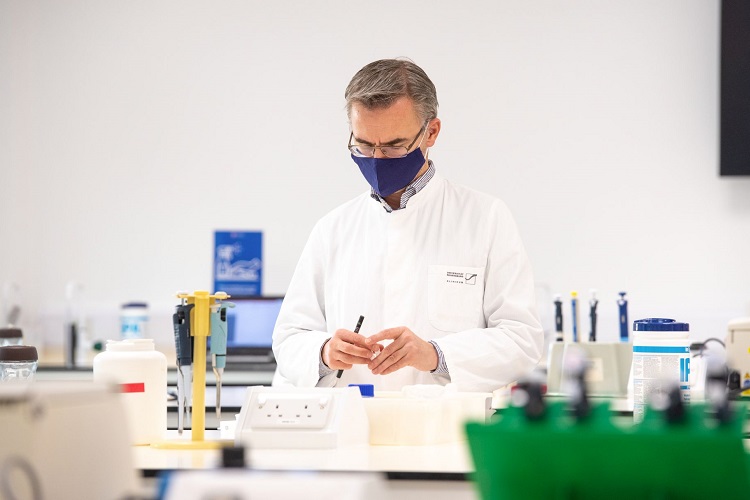
“The teaching lab may be a safer place than your local supermarket.”
Dr Michael Nevels, School of Biology
“It felt really good returning to physical teaching, but different from previous years given the safety restrictions. I think that most students appreciated that some of the teaching is done in person, particularly the practical classes for which proper online replacements do not really exist. Practical skills are critical in most areas of the Life Sciences, and they can only be acquired by hands-on training, like riding a bike.
“We tried to change as little as possible from last year’s practicals, but the preparations turned out to be much more time-consuming. Things had to be carefully planned to allow for a good workflow in a Covid-secure environment. They went very well, with no incidents whatsoever.
“They have been slightly less fun though this time with physical distancing, mask wearing and other restrictions in place. The teaching lab may be a safer place than your local supermarket.”
Elizabeth ‘Lulu’ Wareham, from Dubai, graduated virtually with a BSc (Hons) in Biology in June. She stayed in St Andrews for the initial lockdown period, during which time she switched to virtual learning for the first time. By Week 4 of Semester 1 2020, she was back to in-person teaching in Andrews.
“I was shocked,” she said. “Suddenly classes were cancelled and most of my friends had gone home. It was a big change that happened very quickly. St Andrews was a ghost town during this time and it was surreal for the three streets to be so empty.
“Although I found virtual teaching quite easy to adapt to, as I could watch my lectures at my own pace, at times it could be difficult to find motivation. I missed the practical side of Biology and working with my peers. My subject is very collaborative, and this was a missing element of my degree during lockdown.
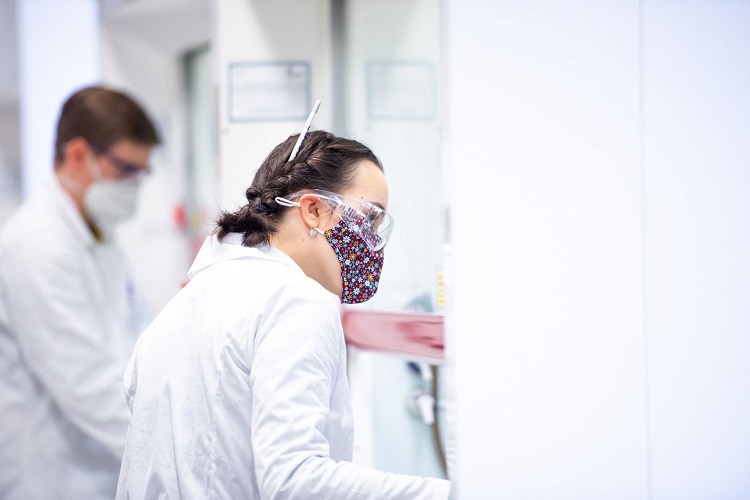
“There are a lot of measures in place to keep everyone safe and I felt like it brought back a bit of normality to university life.”
Lulu Wares, Biology, Class of 2021
“I was apprehensive [about returning to in-person teaching]. There were a few cases in St Andrews at that time and I was worried about being in a room with so many people.
“It was overall a good experience, there are a lot of measures in place to keep everyone safe and I felt like it brought back a bit of normality to university life.
“If you are returning to in-person teaching be reassured that measures such as social distancing and wearing PPE are enforced and the guidelines are very clear and easy to follow. Everyone is working to keep each other safe and returning to the practical aspect of my subject made me feel a lot more engaged with my course.”
Dr Helen Connaris is a Lecturer in the School of Biology and Senior Research Fellow with the School of Chemistry. She supports teaching of a number of third- and fourth-year Biology modules. From the beginning of lockdown, Helen was one of a handful of essential workers in the St Andrews labs with one aim: to find ways of beating Covid-19.
In September 2020, Helen started teaching online, and returned to in-person classes in Semester 1, ‘greatly aided’ by the technical support staff who were able to prepare all the relevant material and equipment for students to perform experiments, while social distancing.
She explained: “From the beginning of lockdown my time was spent in the BSRC Annex labs leading the research team whose work was focused on the use of novel protein biologics (developed in-house) against coronaviruses, including the Covid-19 virus (this being outsourced).
“The experience of coming into work every day as one of a handful of essential workers from the start of lockdown was quite surreal as the labs and buildings were almost empty of people for a few months but, at the same time, I felt completely safe to move around with a mask, and to travel by car back and forward from home.
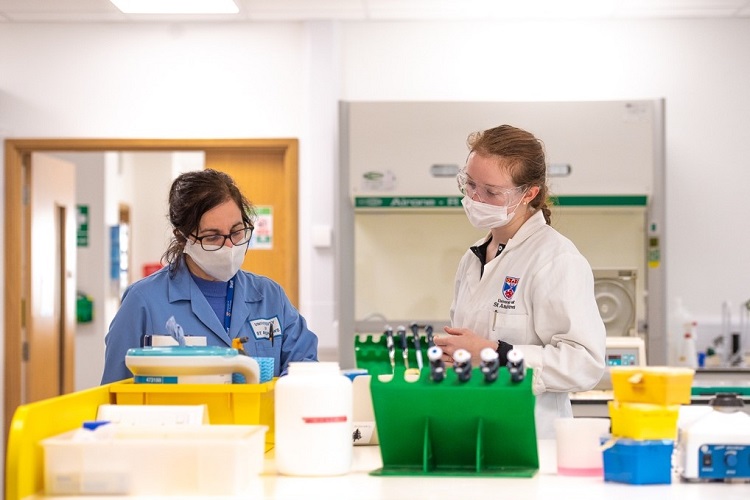
“The idea of seeing and interacting (albeit social distancing) with students and other members of staff face-to-face was a big plus and relief after a long period of very little contact with others during lockdown.
“From speaking to those students who started in the practical labs in September and October, [there was] a mixed response of anxiety and apprehension, but all were happy to be there, as some of the students hadn’t mixed with others since lockdown.
“From student feedback on the practical lab days, many were happy to be there and were relaxed after settling in, once they were reassured about the safety measures (i.e., masks, gloves, lab coats, social distancing) and what they had to do with their work. All the students returned again to continue with labs when timetabled and continued to produce good results from their experiments as well!”
Will Bowes, from Durham, graduated virtually with a BSc (Hons) in Biochemistry in June. He returned to St Andrews for in-person teaching in October 2020 after spending lockdown studying virtually with his shielding girlfriend in Wiltshire.
“Both of us went nowhere at all for two months,” he said, “but we enjoyed each other’s company and I got to go up to Salisbury Plain for my walks at night to photograph the stars.
“I felt it [switching to online learning] was the right change to make, and I enjoyed the content being released via Teams and Panopto. It allowed for more freedom, as I knew there were always recordings I could listen to again once the class was over. And I could go and get a coffee while the lecture was on, which was great!
“I do think I concentrated slightly harder with in-person teaching as you’re in a class with all the other people who are all doing the same but, at the same time, not all of the in-person things were recorded, so you had to make sure you understood it first time and got it right. I listened to every recording at least twice before my exams and it really helped to consolidate knowledge.
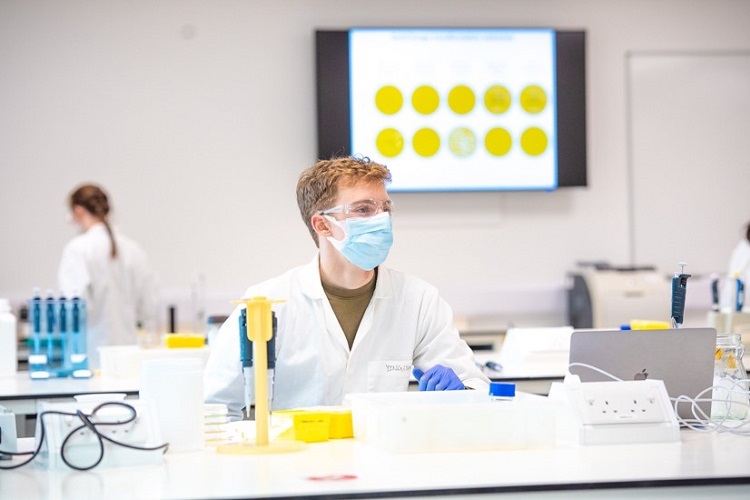
“I was nervous about it [returning to class], particularly as my girlfriend was not allowed to return to in-person as she is shielding, yet I had to, even though I still saw her regularly. It meant I was even more aware of close contact with others in the lab and it was a little stressful.
“It was well thought out and done – being a biochemistry lab, all the PPE and precautions were taken, so I felt as safe as I could have done. The University does everything it can to make it as safe as possible. I felt less safe going to Tesco than I did in a lecture or lab.”
Freya Masters, also a Class of 2021 Biochemistry (Hons) graduate, has a rare type of muscular dystrophy which makes her vulnerable to complications should she catch the virus. As a result, she has been shielding at her family home in Wiltshire and completed all her learning online.
A keen science communicator, Freya spent the summer writing blogs for the University’s Public Engagement (PE) team, volunteering, Facetiming friends and writing a book. Her motto: ‘Keep busy!’
“I tried to focus on all I could do and how lucky I was to live in the countryside, rather than the actual position I was in,” she said. “I got involved in the PE blogs, making children’s quizzes for the St Andrews PE Facebook page, writing blogs for the Biochemist online and volunteering for Ignite Hubs (creating resources to get young children from disadvantaged backgrounds into STEM).
“My parents had to be extremely careful and only went out for shopping once a week, whilst both working from home. My boyfriend Will actually got stuck with us for lockdown which was hilarious! Aside from finishing deadlines and completing exams, we would enjoy the gorgeous weather (there was a huge heatwave in May down in Wiltshire) and spent a lot of time walking in the countryside.
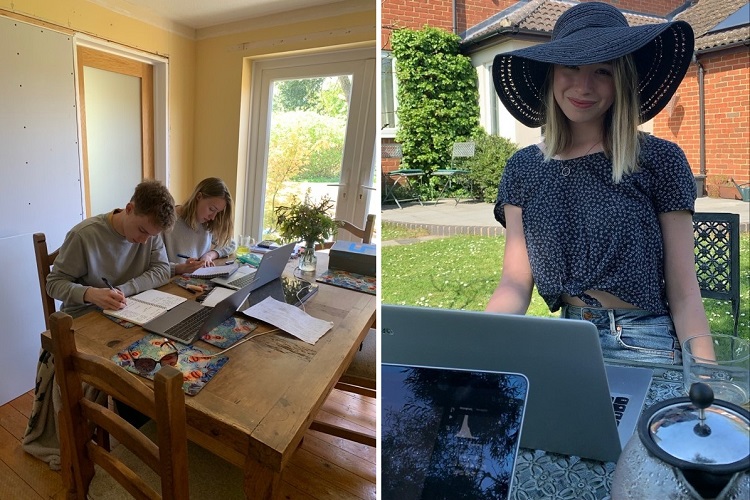
“Interestingly, I feel I fared better in my exams than ever before as the added stress of past access issues was absent due to the online learning. I then could focus more on my studies as added worries were gone.”
Freya, pictured studying at home left with boyfriend Will, and in her garden
“It was odd at first [switching to virtual learning] but something I soon got used to. It was tricky at times as some of the lecture recordings were not as good quality as others.
“I enjoyed in-person teaching because of the routine; trying to keep a sense of routine when you could watch the recordings whenever was difficult at first. It was strange, but a strange time for everyone!
“Over summer I made sure to write some blogs for the Public Engagement team at St Andrews, which involved me interviewing some members of staff over Zoom about their views on PE and then compiling their answers into blogs. I returned to Uni three weeks later than I normally would to assess the cases in St Andrews and, although I am now not being advised to fully shield, my flatmates were really wonderful and extremely careful to ensure my safety, which meant I could return.
“I would feel daunted at the prospect [of returning to in-person teaching] initially, however, would definitely look forward to the social aspects. Interestingly, I feel I fared better in my exams than ever before as the added stress of past access issues (some lecture halls weren’t really suitable access-wise) was absent due to the online learning. I then could focus more on my studies as added worries were gone.”
Vivek Prasad is a lecturer in the School of Economics and Finance. Having completed his teaching commitments in Semester 1 of 2020, he was already effectively working mostly from home when the first lockdown kicked in.
His first piece of virtual teaching was a talk to third-year students at the end of April last year, relying exclusively on the University’s video tutorials to learn about online delivery. Vivek returned to teaching in-person in Week 3 of Semester 2, 2020.
He said: “I gave that first talk with a live Panopto webcast. I’ve been using Panopto for a number of years, both in class and offline. Even though I never did a live online lecture before, learning how to do it was pretty simple for me.
“One downside of a live Panopto webcast is that you do not know how many students are watching live. I know there were students who were live, and I got some questions during and after the webcast, so that suggests the system worked as it should.
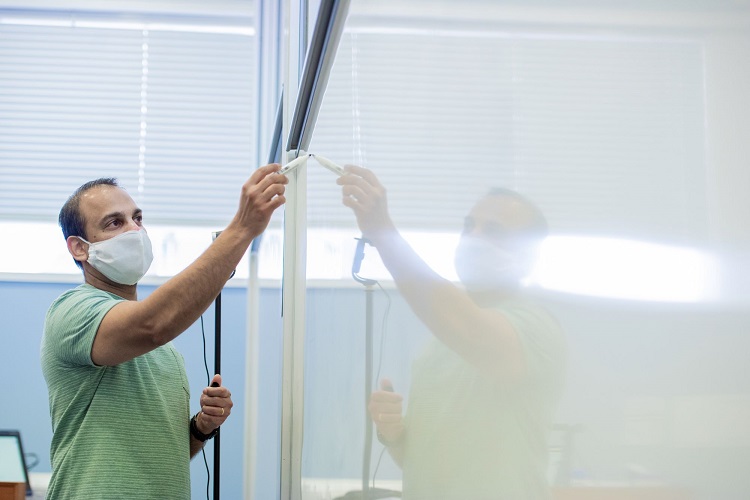
“A great deal of credit must be given to students, who have adhered to the rules, and to University staff who have made in-person teaching possible.”
Vivek Prasad, School of Economics and Finance
“There were two main aspects of this preparation [for the blended model of teaching]: learning how to teach online and knowing what social distancing would imply for in-person teaching.
“Most of us had taught online in lockdown, so this was an opportunity to fine-tune our understanding of the technology. For me, that meant learning Teams for the first time, which I found daunting since the software is so versatile.
“I enjoy in-person teaching, so I really missed not being able to interact with students, get their questions live in the class, and instantly gauge their understanding through body language.
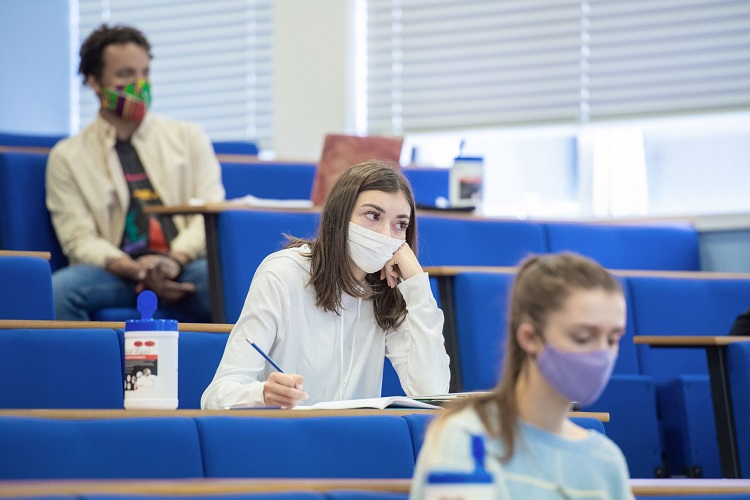
“I was very concerned about catching the virus. But when I started teaching that concern diminished when I saw the measures taken by the University. My students have followed the rules, so that was an added measure of reassurance. They took the safety measures seriously, so my guess is they too were concerned about catching the virus.
“My in-person classes have gone well. They feel very similar to pre-lockdown classes (of course, minus things like group work, after-class private Q&A, etc), and I don’t even notice the loss of five minutes at the end to facilitate cleaning. I think now that students have access to recorded lectures and tutorials there’s some offset to what has to be given up.
“A great deal of credit must be given to students, who have adhered to the rules, and to University staff who have made in-person teaching possible.”
Rhiannon Purdie is a Professor of English and Older Scots with the School of English and normally teaches third- and fourth-year students.
Having spent the first lockdown period in Anstruther – and grateful that she wasn’t in a city – Rhiannon got by online teaching during this period on a “wing and a prayer”.
“Honours class was already keen and well-bonded so they got through ok,” she said, “though we lost a couple of the twenty towards the end. First years tended to drop out after the first couple of weeks. [It was] new and strange for all of us, so we all just muddled through.
“I most missed informal chats with students before and after class. And not having to deal with endless, unfamiliar and often only partially functioning technology on top of the normal stresses of teaching!
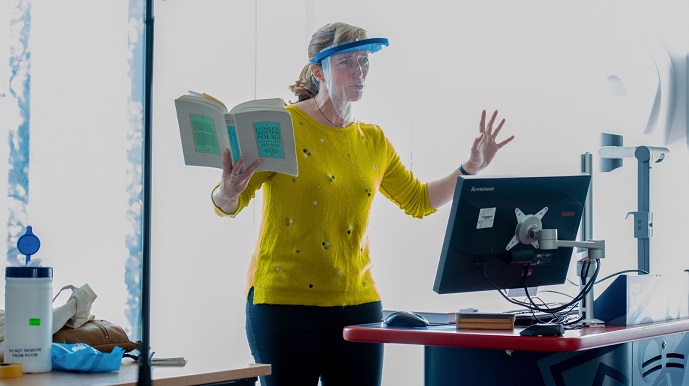
“Those who came to classes were really happy to see their fellow students in the flesh, even if they had to wear masks, and that was quite sweet.”
Rhiannon Purdie, School of English
“I began in-person teaching in Week 3, in at the deep end with nine different groups of students (ten hours of classes) per week. I thought I’d prefer it to online teaching and was naively looking forward to returning to a classroom.
“But between the muffling masks and the struggle to balance live and online cohorts in the same classroom with their intermittent connection issues, I have found it exhausting and we cover far less than either fully live or fully online.
“None of the classrooms was set up for the kind of teaching we do (i.e., group discussion), which was depressing. It has made me long for another full lockdown, to be honest.
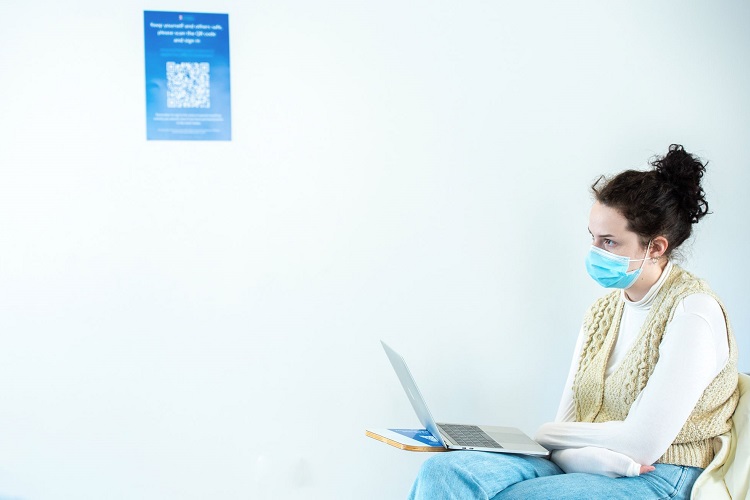
“Those who came to classes were really happy to see their fellow students in the flesh, even if they had to wear masks, and that was quite sweet. Some of those who remained online did so out of fear of contact; others seemed to do so because it was easier to avoid participation that way (such students tended to refuse to switch their cameras on too). But they were a minority: most were just relieved to see any signs of normality return.”
Alice Harmer, from London, is in her fourth year of studying Medicine. She spent the first lockdown at home with her family, switching to online learning in March 2020, and returned to in-person teaching in orientation week, one week ahead of the rest of the University.
“It was strange having to leave university and adjust to new national rules and restrictions, but I enjoyed spending time with my family,” she said. “We switched to online teaching soon after leaving university in March, which was a big change as medical teaching is usually very ‘hands on’, with lots of clinical skills and lab-based classes that are not feasible to do online!
“Having nothing but lectures and a few online tutorials was a big contrast compared to our usual busy and varied timetable, and I missed being able to learn alongside my peers. We also learn a lot from communications skills classes and speaking to patients on placements in hospitals, and not being able to do this for a few months felt like missing quite a big part of traditional medical school teaching.
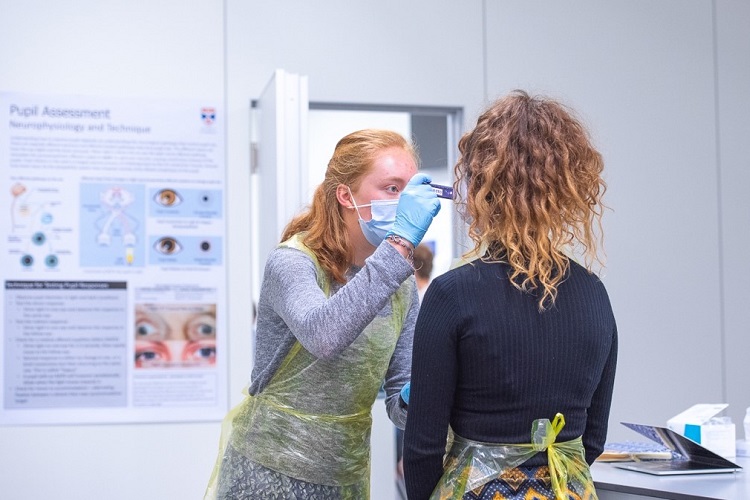
“There is so much to be gained from having classes in-person instead of online – simply the act of walking to a lesson in a University building makes a big difference to how work is approached.”
Alice Harmer, left, fourth year Medicine
“I was excited at the prospect of returning to in-person teaching, and the medical school gave clear guidance regarding PPE and social distancing in order to keep everybody safe. We have been put into classes according to our household ‘bubbles’, so I work together with people I live with, which minimises the risks of spreading coronavirus to other households.
“Naturally some students may feel apprehensive and concerned about the prospect of returning to in-person teaching, however, all teaching schools have put measures in place to ensure everyone stays as safe as possible. There is so much to be gained from having classes in-person instead of online – simply the act of walking to a lesson in a University building (compared with sitting at a desk in your room) makes a big difference to how work is approached. There is a greater level of engagement required for in-person teaching, and it is so helpful to be surrounded by staff members and fellow students.
“I am in a bubble with two close friends of mine who are also medical students in fourth year. We really enjoy working together and they are a great source of support!”
Eva Wardlow, also in her fourth year of studying Medicine, flew home to Belfast to be with her family when the University announced its initial switch to virtual learning.
Since then, her classes have been a mixture of pre-recorded lectures and live drop-in sessions, with in-person classes and clinical placements resuming in October 2020.
“It was nice to spend time with my family,” she said, “especially when we got to exams and I would have been stuck inside revising anyway, so that period of lockdown didn’t seem that strange for me. After exams were over it was a nice chance to relax with my family when locked down and catch up after having been away at university for the past few months.
“It was a strange change to make, particularly because in-person teaching feels very important to me as a medical student. There are many skills you just can’t replicate learning online because you need certain equipment or a patient to practice on. As it was near the end of the year, luckily, we didn’t have too many scheduled clinical hours left.
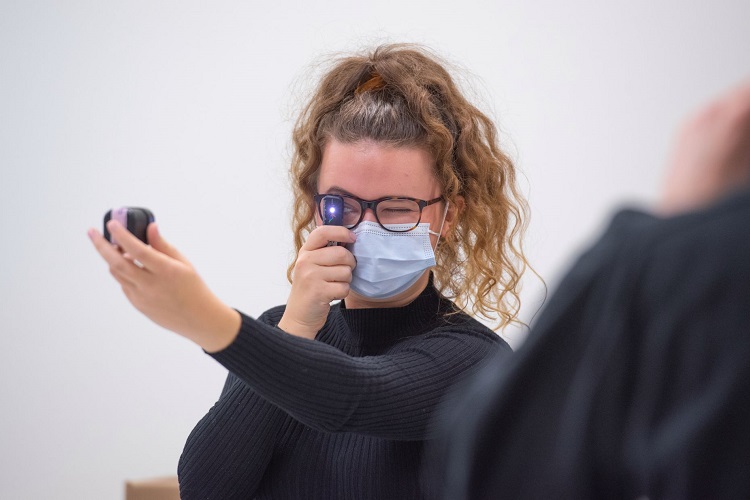
“I feel very lucky to be able to have in-person teaching in a safe and controlled environment so we can continue gaining key skills which we will need as future doctors.”
Eva Wardlow, fourth year Medicine
“A big part of in-person teaching is being able to learn through hands on experience, especially in clinical scenarios. It also gives a real sense of routine and allows you to see your peers frequently – so I really missed the social aspect of it. I also missed our placements in GPs and community hospitals as these are always good opportunities to consolidate learning for the year. I always enjoyed speaking to patients on placement and in the medical school, so it was sad to miss out on some of those classes. Medicine relies so heavily on face-to-face interactions, so it felt strange not to be seeing people every day like I normally would have.
“I think, as with every other stage of coming out of lockdown, it’s hard to imagine what situation you’re going to be walking into, but the medical school have very clear guidelines regarding PPE and social distancing so I knew that we would all be keeping each other safe whilst trying to return to some sort of normality. I had really missed being able to spend time and learn alongside other medical students, so it was great to see my peers in person and be able to work together.
“I have been really enjoying my in-person classes because it is great to have some more face-to-face interactions rather than being stuck talking over a laptop camera. It has been good to speak to patient partners again and to patients in hospital wards and understand how they have been coping with adapting to the new world we are living in. I feel very lucky to be able to have in-person teaching in a safe and controlled environment so we can continue gaining key skills which we will need as future doctors.
“In-person teaching is a very valuable part of our course and allows a great opportunity to put learning into action, so whilst it may seem daunting at first, once you are familiar with the guidelines and changes to teaching scenarios it is a very rewarding experience.
“I am in a social bubble with two other medical students from my year, who are my close friends. We all have clinical skills classes, dissection and labs together and so having in-person teaching with my bubble helps again to reduce the risk of spreading Covid-19 to many other households.
“Now that university life is very different, with regards to limited clubs and society activities, it is really important to be able to have a close group of friends to enjoy the year with, in any way possible. My friends have been a real support for me as we all adjust to a new style of learning and teaching, and I feel very lucky to be able to share the experience with others who are studying the same course.”
Matthew Terry, from Vancouver, is also in his fourth year of studying Medicine. Having already headed back home before the UK lockdown kicked in, Matthew’s classes, dissections and labs were all switched to online delivery.
He returned to in-person classes in Week 2 of Semester 1, 2020, with his first in-person tutorial and a placement at Victoria Hospital in Kirkcaldy.
“Just before lockdown was properly put in place in the UK, my parents urged my sister and me to fly back home to Canada as there were rumours the Canadian borders would soon be closing,” he said. “She and I spent two weeks in our flat in Vancouver isolating from our parents and my grandmother, who were staying in our house in Whistler.”
“The first week felt just like another school week because I had some classes I had to catch up on, but the second week was more difficult. Because my sister and I wanted to reduce the risk for my grandmother, who has asthma, we did not go to the shops and ended up running low on food and rationing for the final days of our quarantine.
“Personally, I was comfortable using the online teaching platform because I had used it all my second semester in first year. I was able to finish all my lectures and get work done much earlier than I would have while studying in St Andrews, but the change of not seeing anyone made attending lectures much less fun and engaging.
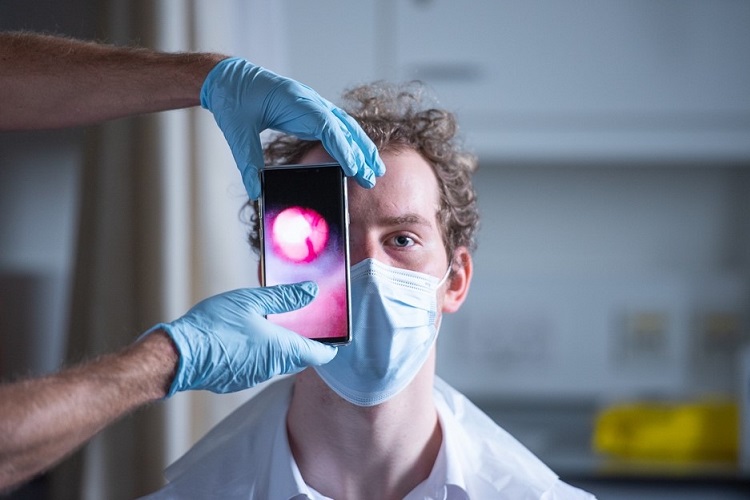
“Being in a place other than St Andrews was a bit of a shock and it was hard to get into the rhythm at first. Once I had spent a couple of weeks in my routine it became a lot easier to study and manage my time.
“I miss seeing different people all the time and being able to talk to them. Now life for me is very much about studying and there isn’t much else to do. When we had a greater number of in-person classes and elements it was easier to have a good work-life balance.
“Everyone respects and understands the importance of wearing PPE properly and having proper sanitation and distancing during the in-person elements, this made it much more comfortable. I was not concerned because I knew everyone would be doing their part to keep each other safe and take proper precautions.
“It was wonderful to see everyone in person again, the few people I saw. It was also much easier to be present and learn the material that was being shown to us. After the dissection class, I felt a little bit more energised after not seeing people for quite a long time.
“Being in-person has many benefits to learning and to one’s mental health. Those who are attending in-person classes are taking proper precautions and the environment they are taking place in is being tightly regulated, so the risk is very low.”
Maggie Ellis is a lecturer in Psychology & Neuroscience and – with a prohibitively large class size of 63 – has been teaching her students virtually from home in Monifieth, near Dundee, since September 2020.
Although she misses her students, with guest speakers (on her specialist subject dementia) and Oscars-style awards ceremonies, Maggie’s online classes have themselves become unmissable.
“I was really apprehensive about it to begin with,” she said. “Having never taught in this environment before it was really hard to predict how the students would take to it. However, I’ve received some really positive feedback despite the change in learning environment.
“I made sure that my lectures were as interactive as possible within online restrictions. I also prepared a wider range of materials to help students understand assessments and critically analyse the literature.
“I missed getting to know my students without a doubt! I make a real effort to develop a good working relationship with my students and this was very difficult in the online environment.
“For me, I would say the only advantage was being able to stay at home with my dog (and to virtually introduce the students to him). Other than that, I really missed seeing people and interacting with them. For the students, I think the advantages were probably not having to get out of bed in the morning for my nine am class!
“We know it [remote learning] works and that people still get a lot out of it, however, I think it’s important for students to create and/or maintain relationships with their peers whether they are at home or in uni. It’s so important to stay connected.
“I think it would really help if more students turned their cameras and mics on during class. Hardly anyone does and it feels really strange to talk to a blank screen. I think this would encourage them talk to each other more as well as me!
“Something different we did for the students this year was to have an online awards ceremony. We have class presentations every year for the best group presentation as voted for by the students. We usually have chocolate and play music in class but this year we took it up a notch. We had been discussing how nice it would be to have an excuse to dress up, so I turned the prize-giving into a Hollywood style awards party and invited the students to get dressed up and turn their cameras on.
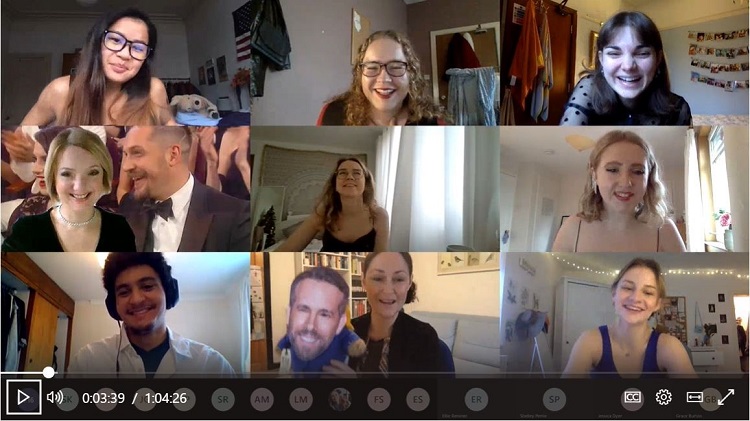
“I invited my colleague Paula Miles to announce the ‘awards’. She pulled out all the stops and wore a ballgown and even had a red carpet (which I think might have been a towel). Even Tom Hardy and Ryan Reynolds showed up! We all had great fun and it was a lovely way to end the module.
“I can’t wait to return to in-person teaching. I’m very comfortable standing up in front of a class and I really miss it. I was restricted by the number of students in my module: I had sixty-three last year so it wasn’t possible to go back to in-person teaching last semester.
“I hope to be back as soon as I possibly can, for us all to be healthy and to have the chance to get back to some sort of normality.”
Words and images (unless otherwise stated) by Gayle McIntyre, Corporate Communications, longform design by Lauren Sykes. With thanks to all subjects and teachers for sharing their experiences and allowing access to classes and labs during this period.
For further information on teaching arrangements for first semester, please consult our updated FAQs.
Contact
Email: [email protected]
Phone: +44 (0)1334 46 7323